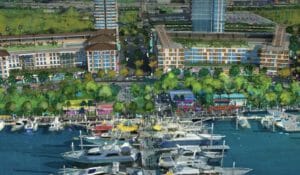Top Story
The Building Healthy Places Initiative member spotlight highlights the work and expertise of a ULI member working at the intersection of health and the built environment.
Peter Rummell is the principal of RummellMunz Partners and has been active in the real estate development industry for over 40 years. He started his career at Sea Pines Company on Hilton Head Island, SC and then held various positions at Arvida Corporation in Florida. From there he went on to become Vice-chairman of Rockefeller Center Management Corporation, Chairman of Walt Disney Imagineering and Chairman/CEO of The St. Joe Company (NYSE:JOE). Peter served as chairman of the Urban Land Institute from 2011 to 2013.
How have you seen the focus on human health evolve within the design, land use, and real estate fields over the past several years?
This is key—why this focus and why now? While I am not a psychologist, I am a developer who has been building places around the world for over 45 years. My experience tells me that as my fellow baby boomers age and become more conscious of our own mortality, that realization is spilling over to the generations behind us! We are all witness to something that is more than a trend—[a focus on health] is a new way of living that is here to stay. Today, there is an ever-increasing interest in healthy living and living longer while also being productive longer, and it has had an impact on me. Someone who is 30 today is starting to look at someone who is 70 and saying “if I start now, I won’t have the problems that idiot has!”
My theory is that healthy living is the new golf course—the amenity that all developers are going to want—but healthy living doesn’t take 125 acres and cost $15 million to install like a golf course and the country club lifestyle. Developers are figuring that out, but only to a point. The real key, and the one that we are focusing on, is going beyond the built environment and creating a software and programming overlay that brings [healthy living] to life in a very real way.
How are you currently working to integrate health into your your newest project, The District, in downtown Jacksonville along the banks of the St. Johns River?

Rendering of The District, a community under development in Jacksonville, Florida, that is designed to promote healthy living.
We have taken the healthy living idea, added integrated layers of programming and measurements to it, and then brought in what I call the major differentiator—multi-generational living. The older I get, the more important it is to me to not become isolated in some sort of age restricted environment. I recently turned 71 and there is no way I am going to get myself isolated in some age restricted place. That may be in the cards someday, but I am going to fight it for as long as I can, and so are others like me. And I want to fight it with 30-year olds around me. I have also found out that the 30-year olds don’t mind having people my age around them either.
Another important aspect that we are building into our plans is that if your Wednesday needs to be exactly like Tuesday, then this is probably not the place for you. We are creating an urban resort—but it is also going to have a vibe of experimentation flowing through it and the people that live, work and play there will thrive from that creative and energetic aspect of life in The District.
Where do you see the fields of real estate and land use needing to focus efforts in order to ensure that health is at the forefront when making project decisions? What types of new partnerships are important to this effort?
Too many developers and planners are focused on design and master planning. Yes, they are important, and we have spent nearly two years on those aspects of our project. But, they are stopping short of the goal that we think is the game changer: the software and programming. A solid menu of activities helping people define “healthy” on their own terms—that is what is important. Not just putting in wider bike paths or vitamin-infused showers. But creating an atmosphere where it is totally okay to go have a glass of wine at 6:00pm is as key to well-being as making time for your workout or mental stimulation and social well-being. The atmosphere can’t be weird though—you have to be able to live your life the way you define it and we need to give you the tools and the options. I am convinced that is not as easy as it sounds and will take some work.
The final thing we have done [at the District] is form a series of very important partnerships with organizations who have also been thinking about [health] but from their specific points of interest. Those groups include the American Heart Association and their overall concern about healthy living; Jacksonville University, collaborating with their amazing collection of disciplines helping bring all this together; Panasonic, who is interested in the technical side of implementation and has experience in building smart communities around the world; and Guidewell/Florida Blue who are very focused on health outcomes, technologies and innovation.